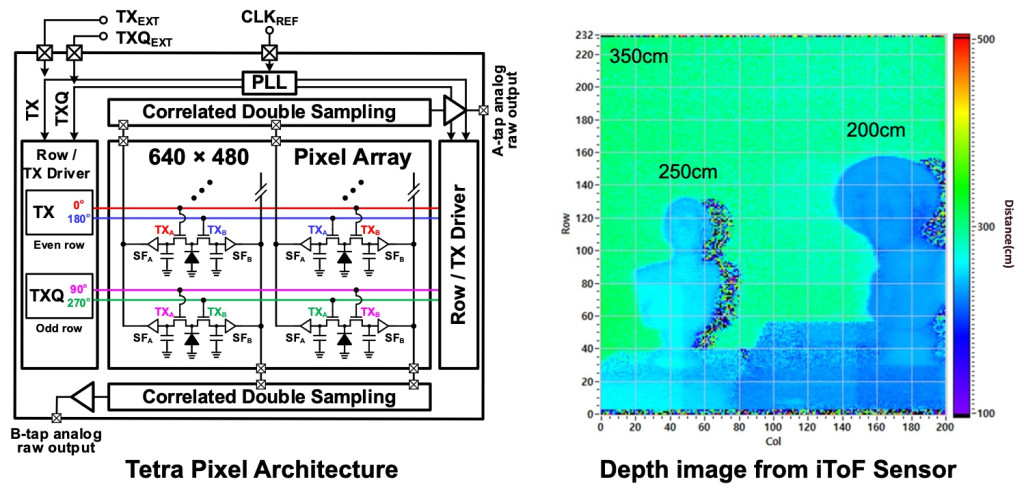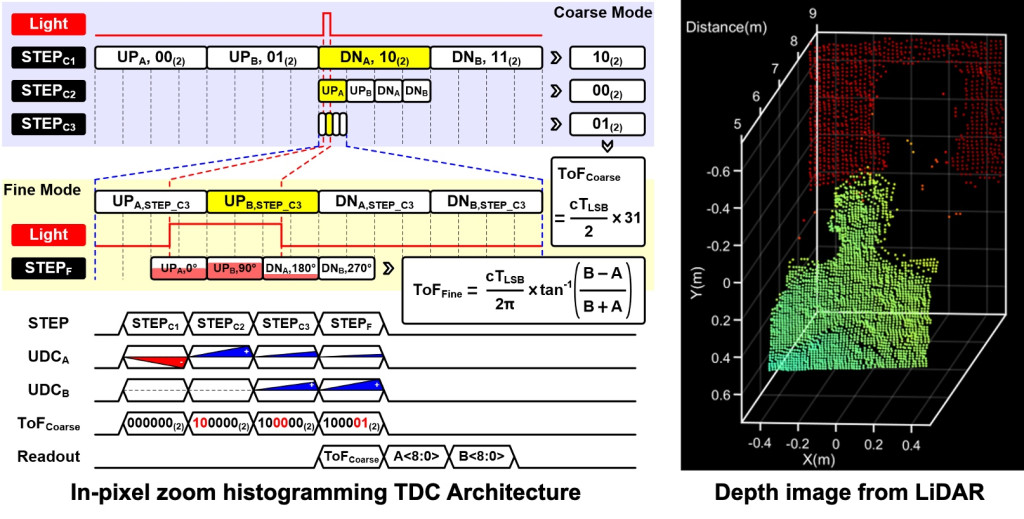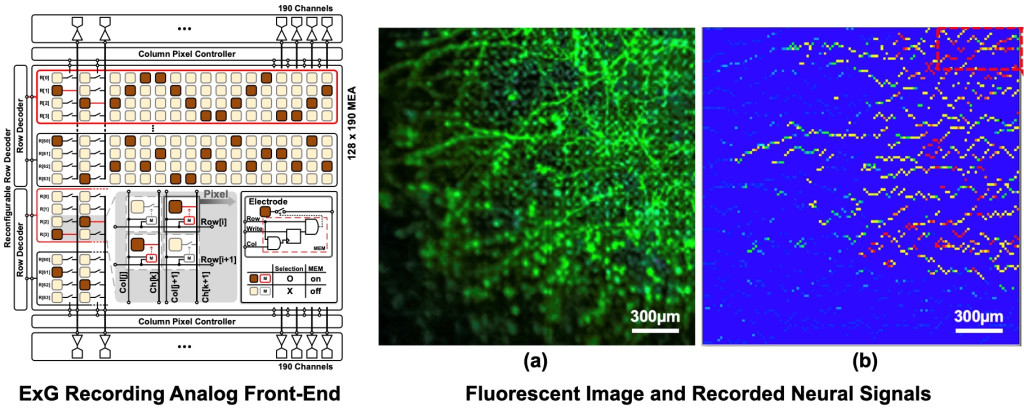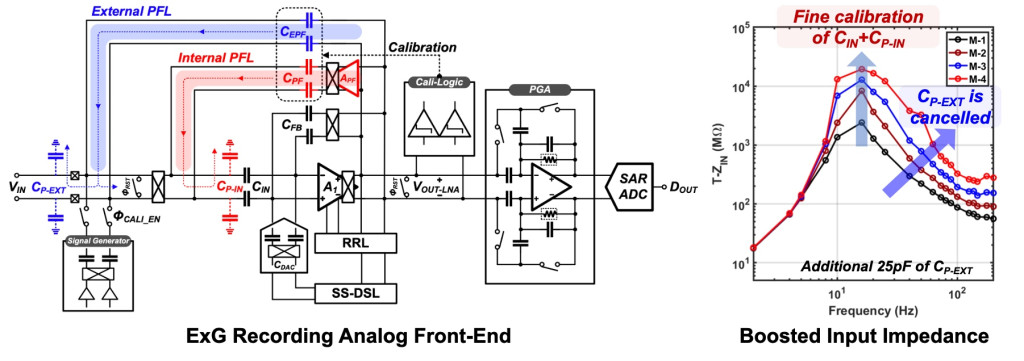We aspire to build innovative microsystems that can detect and process all kinds of natural and electrical signals such as light, impedance, bio-potential, and so on, implemented by low-power low-noise analog integrated circuits and systems technology. We are currently focusing on two main subjects, image sensors and biomedical interface systems. Please contact us if you want to know our work and capability in detail or consider collaboration to advance this field.
CMOS Imager and Range Sensors
LiDAR sensors based on Time-of-Flight (ToF) technologies have become one of the key building blocks to realize metaverse applications with VR/AR in mobile devices and level-5 automotive vehicles in recent years. There are two kinds of ToF technologies; one is the direct ToF (dToF) to measure the time difference between the emitted and reflected light pulses, and the other is the indirect ToF (iToF) to detect the phase delay of the modulated light signals. The dToF is desirable for the applications of detecting a few hundred meters range under a strong background light condition, while the iToF is appropriate for user authentications and human-computer interactions within a few meters range and an indoor environment.
We optimized the demodulation pixel based on the pinned-photodiode (PPD) structure for operating it towards 100MHz frequency, which was challenging and desirable. The proposed trident-shaped PPD with a two-step doping gradient improved the pixel performance significantly. We also proposed a tetra pixel architecture in that two-by-two adjacent pixels collect in- and quadrature-phase data, alternately, and combine them to generate a depth map by interpolation in a single frame. It can compensate for mismatches on both taps and alleviate motion artifacts.
While the iToF technology is getting mature, the dToF LiDAR emerges as an alternative solution to provide capabilities of long-range detection and strong background suppression. Among unresolved issues in the dToF LiDAR, we paid attention to its huge data rate. Unlike typical iToF sensors, the pixel array in the LiDAR sensor creates ToF information from complicated time-to-digital converters (TDC) in every few µs, which is converted to about 100k – 1Mframe/s. Considering the number of pixels, the LiDAR generates a few Gbps data, consuming large power and requiring large memories. We proposed an in-pixel zoom histogramming TDC architecture for massively parallel depth estimation in a cost-effective small-size form factor without a rotating part. The proposed zoom TDC decides two bits of the ToF value at each step period in the quaternary search manner, eliminating several memories corresponding to histogram bins. The duration of the histogram bin is shrunk by a quarter in every operating step, and a coarse depth value is created after whole step periods without any post-processing. The iToF technique to support fine depth resolution is also improved by adopting Δ-intensity phase detection with the four different phases. Inherent time-gating and differential signaling features suppress the common-mode noise, achieving 15mm depth resolution at 30klux background light.
<Related Papers>
- Seunghyun Lee, Dahwan Park, Sanguk Lee, Jaehyuk Choi, and Seong-Jin Kim, “Design of a Time-of-Flight Sensor With Standard Pinned-Photodiode Devices Toward 100-MHz Modulation Frequency,” IEEE Access, vol. 7, pp. 130451-130459, Sep. 2019.
- Jubin Kang, Yongjae Park, Jung-Hye Hwang, Jung-Hoon Chun, Jaehyuk Choi, and Seong-Jin Kim, “A 640×480 Indirect Time-of-Flight Image Sensor with Tetra Pixel Architecture for Tap Mismatch Calibration and Motion Artifact Suppression,” in IEEE Symp. VLSI Circuits, Jun. 2022, pp. 44-45.
- Jubin Kang, Yongjae Park, Jung-Hye Hwang, Kieop Hong, Insang Son, Jung-Hoon Chun, Jaehyuk Choi, and Seong-Jin Kim, “An Indirect Time-of-Flight Sensor with Tetra Pixel Architecture Calibrating Tap Mismatch in a Single Frame,” IEEE Solid-State Circuits Letters, vol. 5, pp. 284-287, Dec. 2022.
- Bumjun Kim, Seonghyeok Park, Jung-Hoon Chun, Jaehyuk Choi, and Seong-Jin Kim, “A 48×40 13.5-mm Depth Resolution Flash LiDAR Sensor with In-pixel Zoom Histogramming Time-to-Digital Converter,” in IEEE Int. Solid-State Circuits Conf. (ISSCC) Dig. Tech. Papers, Feb. 2021, pp. 108-109.
- Seonghyeok Park, Bumjun Kim, Junhee Cho, Jung-Hoon Chun, Jaehyuk Choi, and Seong-Jin Kim, “An 80×60 Flash LiDAR Sensor with In-Pixel Histogramming TDC Based on Quaternary Search and Time-Gated Δ-Intensity Phase Detection for 45m Detectable Range and Background Light Cancellation,” in IEEE Int. Solid-State Circuits Conf. (ISSCC), Feb. 2022, pp. 98-99.
- Seonghyeok Park, Bum-Jun Kim, Su-Hyun Han, Junhee Cho, Jung-Hoon Chun, Jaehyuk Choi, and Seong-Jin Kim, “An 80×60 Flash LiDAR Sensor with In-Pixel Delta-Intensity Quaternary Search Histogramming TDC,” IEEE J. Solid-State Circuits, vol. 57, no. 11, pp. 3200-3211, Nov. 2022.
- Su-Hyun Han, Bumjun Kim, Seonghyeok Park, Yongjae Park, Jung-Hoon Chun, Jaehyuk Choi, and Seong-Jin Kim, “A 100×80 CMOS Flash LiDAR Sensor with 0.0011mm2 In-Pixel Histogramming TDC Based on Analog Counter and Self-Calibrated Single-Slope ADC,” in IEEE Symp. VLSI Circuits, Jun. 2022, pp. 82-83.
Brain and Body Interface ICs
Biomedical circuits and systems cover diverse research subjects such as wearable healthcare monitoring devices, point-of-care diagnosis systems, implantable neural interface ICs, DNA sequencing arrays, and so on. Among them, we have been passionate about developing neural recording ICs that can monitor electrophysiological activities from a single neuron to provide them to neuroscientists and ultimately realize artificial prosthetics. The complexity of the human brain containing nearly 100 billion neurons with hundreds of trillions of synaptic connections prevents us from investigating neuronal communication for a comprehensive understanding of the brain despite rapid advancements in electronics and neuroscience. The number of electrodes and readout channels of in vivo recording microsystems has doubled every seven years, reaching 966 electrodes with 384 readout channels, which remains far below the number of neurons.
A microelectrode array (MEA) system featuring high-density electrodes and low-noise AFEs is an alternative solution to acquire extracellular potentials from in vitro multiple neurons. MEA systems with tens of thousands of electrodes have been reported in recent years. However, they still suffer from area constraints in the low-noise AFE and connection complexity from electrodes to corresponding AFE channels. We proposed an MEA system with sub-array multiplexing architecture for programmable electrode selection and readout speed to maximize the ratio of the number of recorded electrodes per frame to the total number of electrodes. A time-division multiplexing scheme allows each AFE channel in a column to record multiple electrodes one by one in a given sampling time, alleviating the routing complexity and the number of AFE channels. The prototype MEA system demonstrates two different experimental scenarios with neurons cultivated on the MEA. One is exploring synaptic connections from sparsely distributed neurons by configuring the sub-array to eight with the frame rate of 20kS/s, and the other is observing propagation of extracellular potential from local neurons by configuring the sub-array to one with the frame rate of 10kS/s.
Another primary research subject is to design low-noise low-power bio-potential recording AFEs for wearable healthcare devices. A capacitively-coupled chopper instrument amplifier (CCIA) with dry electrodes has drawn much attention to support stringent specifications, µW-level power consumption and input-referred noise of a few µVrms. However, its input impedance should be inherently limited by the chopping technique and large parasitic capacitance stemming from complex environmental interfaces. We proposed a two-step digital-assisted DC servo loop (DSL) and dual positive feedback loops (DPFL) to compensate an electrode DC offset (EDO) up to ±380mV and boost input impedance to 15GΩ at 10Hz frequency, respectively.
<Related Papers>
- Ji-Hyoung Cha, Jee-Ho Park, Yongjae Park, Hyogeun Shin, Kyeong Seob Hwang, Il-Joo Cho, and Seong-Jin Kim, “A Reconfigurable Sub-Array Multiplexing Microelectrode Array System with 24,320 Electrodes and 380 Readout Channels for Investigating Neural Communication,” in IEEE Int. Solid-State Circuits Conf. (ISSCC), Feb. 2022, pp. 342-343.
- Ji-Hyoung Cha, Jee-Ho Park, Yongjae Park, Hyogeun Shin, Kyeong Seob Hwang, Il-Joo Cho, and Seong-Jin Kim, “A CMOS Microelectrode Array System With Reconfigurable Sub-Array Multiplexing Architecture Integrating 24,320 Electrodes and 380 Readout Channels,” IEEE Trans. Biomed. Circuits Syst., vol. 16, no. 6, pp. 1044-1056, Dec. 2022.
- Yongjae Park, Su-Hyun Han, Wooseok Byun, Ji-Hoon Kim, Hyung-Chul Lee, and Seong-Jin Kim, “A Real-Time Depth of Anesthesia Monitoring System Based on Deep Neural Network With Large EDO Tolerant EEG Analog Front-End,” IEEE Trans. Biomed. Circuits Syst., vol. 14, no. 4, pp. 825-837, Aug. 2020.
- Yongjae Park, Ji-Hyoung Cha, Su-Hyun Han, Jee-Ho Park, and Seong-Jin Kim, “A 3.8-µW/Ch, 15-Gohm Total Input Impedance Chopper Stabilized Amplifier with Dual Positive Feedback Loops and Auto-calibration Scheme,” in IEEE Symp. VLSI Circuits Dig. Tech. Papers, Jun. 2021.
- Yongjae Park, Ji-Hyoung Cha, Su-Hyun Han, Jee-Ho Park, and Seong-Jin Kim, “A 3.8-µW 1.5-NEF 15-Gohm Total Input Impedance Chopper Stabilized Amplifier with Auto-calibrated Dual Positive Feedback in 110nm CMOS,” IEEE J. Solid-State Circuits, vol. 57, no. 8, pp. 2449-2461, Aug. 2022.




